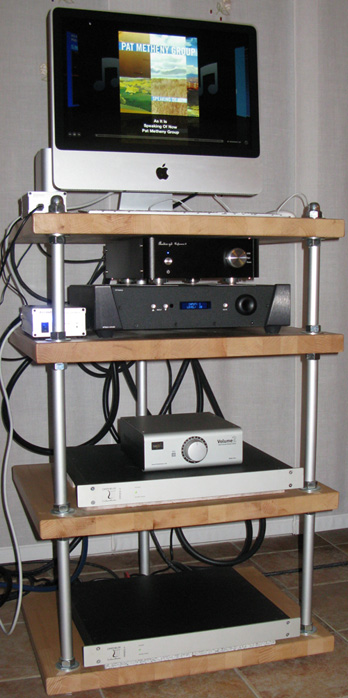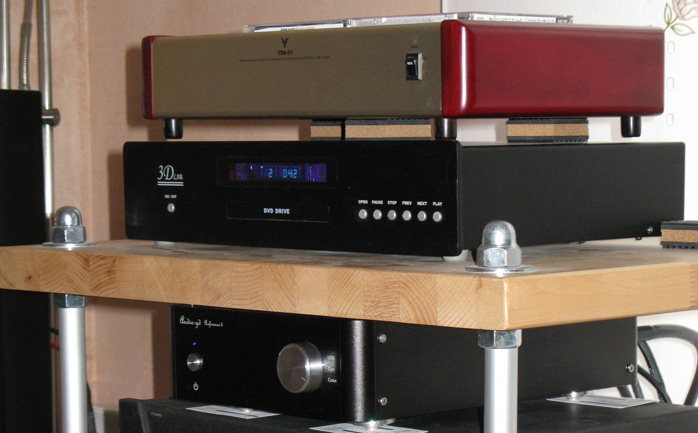This review page is supported in part by the sponsors whose ad banners are displayed below |
 |
 |
 |
Sound: I experienced the Ref 5 in various contexts and thought that in most cases, it presented an interesting upgrade over integrated CD players up to $3.000. With different transports, I mostly used the S/PDIF interface. The Audio-GD Reference 5 worked perfectly with my Audio Analogue Grand Maestro CD player which has proved quite unforgiving with several other external DACs. On the other hand any sonic improvement was less obvious with a CEC TLX-51 player. The CEC drive seems a far better performer from its BNC output, which I couldn’t experiment with during the limited time I spent with the Sino-German player. With low-end partners such as my daughter’s Marantz CD50, the Reference 5 DAC was more than convincing.
In short, I’d describe the Audio-GD’s contributions as added transparency, more detail, a wider soundstage and increased bandwidth. The most remarkable attributes were the silent background and a soundstage that delivered unusual coherence and spaciousness in this price range. The sonic imagery was so dense that it gave an impression of a solid screen without any discontinuity. The quality of tones at the upper end was average with an arguably somewhat darkened midrange to blend seamlessly into systems whose tonal balance shows an emphasized treble. The association with the Audio Analogue Grand Maestro CD and its airy treble and a gorgeous upper midrange register was a perfect match.
The Ref 5 DAC sonic identity reminded me indeed of Krell and Levinson. As clearly stated by Qinghua, the Chinese converter works significantly better when used with its balanced outputs. While the unbalanced weren’t poor and in fact very commendable, the balanced outputs simply delivered a further level of transparency and silence. My comparisons and opinion in this review are thus based on balanced playback as advised directly by He Qinghua on his website: “If you only want to use the RCA outputs and do not plan on going to a balanced systems in the future, you are better off considering the DAC-19 over the Reference 5 and save some money”.
|
|
|
|
Compared to my Yamamoto YDA-01, the Audio-GD was outdone and these competitors also clearly represented opposing design philosophies. The Chinese is a monster of complexity while the Japanese with its passive I/V conversion is the epitome of simplicity and straight-wire philosophy. The resolution of the Japanese rival was superior in association with my Audio Analogue Grand Maestro and 3DLAB CD-SACD drive. That repeated itself outside my home when I compared both converters in a system composed of an Icos CD-PRO Drive, Karan integrated amplifier and a beautiful pair of ASI Tango speakers (hello editor!). The Yamamoto delivered a superior tonal balance, more fluidity and in general was more organic and lively. Obviously the Reference 5 DAC offers more than one solitary coaxial input and is more flexible.
|
 |
I noticed that the Audio-GD produced significantly different results according to what transport preceded it. While a banal observation in itself, I would simply insist on its importance despite the claims for the DSP-1 board. The Yamamoto seemed more insensitive to what drove it whilst being more transparent. The Japanese responds to quality ancillaries by clearly highlighting minor issues elsewhere. The Reference 5 was the more forgiving.
That said, the Ref 5 DAC always performed favorably when compared with others in its own price range (and not against thrice-priced gear like the Yamamoto). To summarize the differences between the YDA-01 and Ref 5, the Japanese had better tone and was more involving while the ultra-regulated Chinese was quieter with an impressive soundstage (even if not as wide as the YDA-01's). In one sense this played out as a juxtaposition of liquidity vs. density. The Yamamoto was utterly liquid while the Audio-GD had impressive depth. Neither the Yamamoto which extracted a little more detail nor the Reference 5 would ever be considered analytical. Each had its own musicality and neither sounded electronic. Both had the ability to keep me listening for hours without fatigue.
|
|
|
 |
With a computer source, the Reference 5 was quite good. It operated completely silent and very transparent.
First I used my iMac and iTunes with no specific add-ons and just the basic requirements (i.e. disabling iTunes’ equalizer and QuickTime audio settings). The Audio-GD device identified itself to the host computer as TE7022 w/ SPDIF. Connected to my RW Audio headphone amplifier and AKG K701, I achieved a greater level of detail that highlighted the different musical layouts of each recording. Curiously the sensation of great image specificity and instrumental separation was even more obvious over headphones. The DAC’s native density remained to complement the AKG’s neutrality well and the Reference 5 DAC in this setup seemed a promising invitation to try out the smallest Audio-GD gear with a direct headphone output.
Next I connected the iMac to my speaker system. The overall result wasn’t bad but darker than expected and with a small loss in dynamics. Suspecting the USB input, I then used the Trends Audio UD-10.1 USB interface with the S/PDIF input of the Audio-GD. I was not expecting particular improvements as the connection to the computer was still based on a USB interface. But facts demonstrated me wrong. As generally good as 44.1kHz files sounded over the Ref 5's USB input, the soundstage flattened somewhat in direct comparison to a 3DLAB CD drive connected via S/PDIF. Passing through the Trends UD-10.1’s USB input meanwhile—powered by the PW-10 PSU—now delivered a very similar result to the 3DLAB drive.
|
|
 |
  |
 |
|